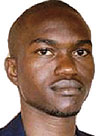On Saturday, I joined thousands of people in Kinigi, Musanze District for the 7th edition of the Gorilla naming ceremony also known as Kwita Izina. It was my second time to attend this annual event after my 2009 debut. For those not in the know, this is an event where baby Mountain gorillas are given names in an effort to draw global attention to the need to conserve the environment in which these endangered animals reside as well as promote tourism in Rwanda.


On Saturday, I joined thousands of people in Kinigi, Musanze District for the 7th edition of the Gorilla naming ceremony also known as Kwita Izina. It was my second time to attend this annual event after my 2009 debut.
For those not in the know, this is an event where baby Mountain gorillas are given names in an effort to draw global attention to the need to conserve the environment in which these endangered animals reside as well as promote tourism in Rwanda.
It is a modification of a known Rwandan custom, where new born babies are given names.
From the time it was started, this event has clearly etched its mark as one of the biggest events on the Rwandan calendar. It always attracts celebrities, conservationists, foreign dignitaries, visitors to Rwanda as well as locals.
Local and foreign media compete to get the kwita Izina story each year without it ever appearing stale to their editor or audience.
This event clearly epitomises a success story when it comes to branding and marketing. And how I wish other organisations and companies could pick lessons from Rwanda Development Board (Tourism and Conservation) on how they do their thing.
The success of the event is best brought out by the fact that some of the people who head to Kinigi for the first time actually think that real gorillas show up to be named! I actually received such queries from some people when I posted something on my Facebook wall and twitter account.
The success of this event is not so hard to demystify. RDB has managed to keep the oomph in this event for seven years going because of good branding techniques. One of their tricks has been simplicity.
Banners, posters and billboards for the event always just mention the event, date and venue. That is all one needs to know. Many companies continue to fail this test by crowding their billboards with a lot of irrelevant information.
RDB has also managed to achieve success because it uses the media extensively to market the event. Both local and international media are used to market and also to cover the event each year. More importantly, they have embraced new media platforms to spread the message.
There is a website dedicated to the event and this is supplemented by their presence of social networking sites like Facebook and twitter.
If RDB can have a website for a single event, then it is modern day economic suicide for any company worth its name to continue having no footprint on the internet. Some companies that have websites continue to use them like billboards. They are not interactive and not regularly updated.
Another major trick from the bag that RDB unleashes to make this event a must attend is the way it makes an effort to indulge the local communities. Before the real day, other events like a cycling race, a regional conference and launching of a community project take place.
The night before D-day, locals are treated to a party frenzy (igitaramo). It is no magic, therefore, that, each year, thousands of Musanze residents trek to the naming site to witness the gala. Do I also have to mention that RDB plans well ahead of time to ensure that everything goes according to plan? Let the wise ones pick their lessons. Bravo RDB!


